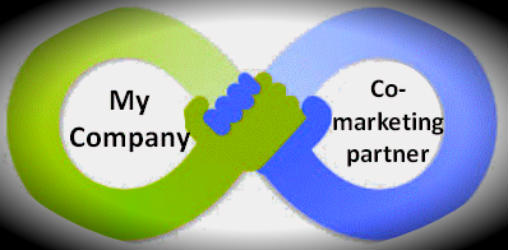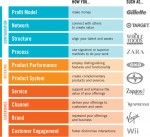
by Rita Baker | May 25, 2015 | Marketing
In today’s business environment where product complexity is increasing, one to one marketing and globalisation are often becoming a must, going at it by yourself is scary at best and impossible at worst. In such a context co-marketing can make a lot of $en$e.
What is co-marketing?
Co-marketing is as encompassing a term as marketing is. If you’re not sure what the marketing function encompasses, a good, but in my opinion still not fully complete, illustration of a marketing framework can be found here. Marketing spans from identifying the customers you will be serving and their needs all the way to managing the customer touch points at the end of your product’s life cycle. Co-marketing is then defined as executing any of the multitudes of marketing activities in between, in collaboration with one or many other organisations.
Co-marketing agreements can take almost any form. It can include a co-branding agreement or not. It can involve a monetary compensation or an exchange of services, resources and/or know-how. There is no set formula. Very successful co-marketing agreements can even lead to the merger of the partners.
When does co-marketing make sense?
Product complexity
I’m seeing it more frequently with Internet of Things (IoT) start-ups and companies. They are often initiated by tech entrepreneurs who know a lot about technology but not so much about design and the distribution channels of their end products. You can choose to acquire all this knowledge in-house but it will take time and a lot of resources to do so. An example of product complexity would be smart wearables. To create a biometric type garment, you need IT engineers, fabric engineers, health scientists, big data analysts, fashion designers and marketers. These talents often don’t speak the same language and evolve in very different work cultures. Combining all of them under one roof can pose not only recruiting challenges, but management issues that are often too great for many companies to overcome especially in the beginning.
Going after many markets at once
If you offer a service or a digital product, selling in multiple markets early on in your business can be done. If you are offering a physical product and you need to be in as many markets worldwide as you can in a short time span (usually because you have a highly innovative or cutting edge technological product that can be copied relatively easily) then going at it by yourself, when you are small is impossible. Reaching out to other organisations that already have deep knowledge of the markets you are targeting is sometimes the only alternative to reaching new markets in time.
Growing your suppliers and key partners network
Co-marketing can also lead to finding new suppliers and key partners. When partnering with a company that has similar value to yours, you may find that you can also grow your (and your new partner’s) network of suppliers and key partners more easily. You and your partner may also look into signing joint purchasing agreements to increase your purchasing power with common suppliers. Joint purchasing power can also mean finding suppliers that are willing to manufacture inputs that are more suited to your products.
There are many other situations where co-marketing makes sense. When you find a, or a few, co-marketing partners, the opportunities will present themselves to you.

A great example of co-marketing partnership is the one between OM Signal, which commercialises smart fitness clothing and the world renowned fashion house Ralph Lauren. In this partnership, OM Signal gained access to fashion design and fashion marketing know-how, potential access to markets worldwide, as well as to great media visibility. In return, Ralph Lauren gained access to expertise in smart wearables and complex technological and big data know-how in a very short time span and at a significant lesser cost than developing it in-house.
In a future post we will look at ways to find a co-marketing partner and how manage the relationship.

by Rita Baker | May 19, 2015 | Marketing
Developing a new export market can be very costly, especially if your sales channels are not only web based. Whether the web is your only sales channel, a secondary one or a support to your traditional channels it can also be a great tool to find your next natural export market. A natural export market is one where there is an already existing fit with your product or service. Developing an export market when you need to make significant modifications to your product will require more effort.
Here is a simple 3 step approach to find and get to know your next natural export market when you can’t count on a sizeable budget or contacts in the new market.
Step 1 – Web advertising/Analytics
Google Adwords and other web advertisers allow you to target the markets where you advertise your products geographically with great precision. Testing the response of your ads in various markets by monitoring how many hits your geographically targeted ads generate is a great way to sniff out your natural export markets. You can start by targeting similar socio-demographic segments to the ones you already sell to on the local front. This tactic could be considered a type of A/B testing where your test variable is not the ad content per se but the geographic area where it is placed.
Step 2 – Social media
Once you have identified your next natural export market, add/befriend/follow potential customers, partners and local associations on various social medias such as LinkedIn, Facebook and Twitter. Start by taking in the contents and conversations for a while before participating in the exchanges. This will enable you to better understand not only potential customers’ needs but also their environment. At this stage, you can also start to test, via your website, the type of content and approach that works best in this new market.
When you build enough of a following and reputation in your new market, you can start on step 3.
Step 3 – Webinars
When you have identified your targets (customers, suppliers, and partners) in your new export market, create webinars that will appeal to the specific target you are going for. These webinars will enable you to demonstrate your value proposition, establish your reputation and get valuable contact information. You can now initiate a dialogue with your targets and engage your sales process.
This 3-step approach can be adapted to approaching new market segments in your local market as well. In future posts I will go into more detail with each of these steps. Stay tuned.

by Rita Baker | May 11, 2015 | Marketing
I am seeing a new trend in the last while. More and more entrepreneurs are incorporating a community aspect to their product and marketing tactics. Personally, I think it’s brilliant.
Aside from the social benefits it can bring, I like it because, if done right, it is also profitable.
Community marketing is definitely not new and is used regularly by non-profit organisations. Until recently however, I had not seen start-ups and small businesses use it much, most likely because of the logistics costs involved. Social media platforms, new technologies and applications are now reducing these costs significantly, thus making community marketing a viable option.
What is community marketing?
Community marketing is a set of tactics used to involve your customers and/or prospect customers (subsets or all of them) and their network with your organisation.
What I very much like about community marketing is that it is based on what I perceive as the guiding principle of any company; answering its customers’ needs. Just to be clear here, I am not necessarily talking about the same needs your product/service is answering. Community marketing can answer needs that have nothing to do with your offering. As long as you succeed in scratching an itch for your customers then you are on the right track.
Community marketing can be done on any scale. Whether you are a start-up, a non-profit organisation, a public organisation or a multi-national there is an abundance of tactics to be used.
Community marketing tactics present great opportunities for co-marketing activities (marketing other brands alongside yours). It can also be used as a catalyst for a company to build a community of its own with other organisations.
Examples of community marketing tactics you can do are:
- Host regular meetups or trainings given by customers for other customers
- Charter a bus to an event your customers will want to attend
- Organise an online game tournament for your customers and their friends and family, where more highly skilled players are teamed with beginners to teach them or help them improve their skills
- Organise the cleanup/beautification of a park or area chosen by your customers
- Invite a group of customers to be employee for a day at your organisation or simply have an open house day with planned group activities
- Ask your customers and their network to help answer the needs of one of your customers and/or someone close to them (such as sending a get well card to the sick child of one of your customers)
Community marketing tactics are usually coupled with promotional tactics such as discounts, preferential treatment or other offers to achieve specific business objectives.
You can also incorporate a form of community marketing in your product/service. You could, for example, offer a specific version of your product/service or a specific pricing when customers buy as a group. You can facilitate this by offering a community exchange platform on your website where customers and potential customers can exchange and organise themselves.(1)
Community marketing done right
In order for community marketing to benefit your organisation it has to be done the right way. Direct financial benefits to your company should not be the main goal, unless you are a non-profit organisation, to maximise the benefits of community marketing, . The main objective is to answer a specific need for as many of your users as possible (networking, transport, learning, cleaning up their environment, accessibility, etc.). The opportunities created by your activity can be used to achieve secondary goals of direct or indirect financial rewards for your organisation.
The more important the need you aim to answer in your customer segments, the better your results will be. Transparency is a key element in all of your community marketing efforts. Your customers will not mind when your company benefits from the marketing tactic as long as your announced objective is clearly attained and you do not hide any of the benefits your organisation is getting out of the activity.
Any attempts to benefit unduly from a community marketing tactic will damage your brand, reduce customer loyalty and could seriously harm your profitability. Unfortunately, it will also make your customer base weary of attempts at community marketing by any other for-profit organisation they deal with.

Benefits of community marketing
As you have probably already figured out, there are multiple benefits to community marketing other than direct and indirect sales.
- Positive brand association
Customers taking part in your community marketing activities, having their needs answered, will associate your brand with positive feelings and good value.
- Community leadership
Establish your organisation as a community leader that initiates positive changes and make their environment a better place
- Better insights into your customers’ needs driving innovation
Multiplying opportunities to be in contact with your customers will enable you to observe them regularly and better understand their needs. Your customers themselves will also feel more inclined to share their needs with you. This will help drive innovation in your organisation.
- Reducing your marketing costs
Activity costs can be shared, if not entirely recovered, by partnering with other companies and organisations.
- Free advertising
There is nothing like doing a good deed for your community to get a positive buzz going in social (and traditional) medias. There is also nothing wrong in tooting your own horn about it.
- Feeling good about what you are doing
As entrepreneurs we don’t always have as much time as we would like to get involved in our community. Community marketing activities are also a way for entrepreneurs to leverage what they are building on a daily basis and share the benefits with others.
There are many more benefits, direct and indirect, related to community marketing. Now that you know how simple it is, why don’t you give it a try.
(1): If the idea of your customers exchanging with one another is making you shudder, it may be time to take action on your total customer experience.

by Rita Baker | May 5, 2015 | Marketing
We are all striving to do more with less. Our goal at the end of our corporate day is to bring home as much money as possible for the least amount of effort while respecting our values. So why am I, a marketing consultant, about to tell you how to reduce your maketing and sales costs? Very simple, a minimal marketing effort requires less effort to bring in larger payouts. It also is more strategic in nature and often requires a higher knowledge and experience base to bring in maximum results.
So what is this big secret to reducing your marketing and sales costs you ask? Innovation is the answer. Whatever it is you want to sell, the more innovative it is, the less marketing and sales effort you will need.
Great you say, but my product/service already exists and it’s not that innovative. So can I still get in on minimising, or at least significantly reducing, my commercialisation costs? There is good news for you because the answer is a resounding yes.
Innovation is a term that has been so overused that it is now jaded. Actually, if you google innovation, you will easily find a dozen different definitions for it. The definition that I like because of its simplicity and makes the most sense in the business world is that of the Ten Types of Innovation by Larry Keeley et al. They define innovation very simply as the creation of a viable new offering.
It implies that innovation will not appear by itself, it needs to be created. It also incorporates the notion of viability. Because it fills a significant need in the market, a true innovation will earn its keep and return money to your organisation. It also uses the term offering and not product. All too often we tend to think of innovation as a new product. Most innovations are not. Take Zappos for instance, they didn’t innovate on the shoes they sell. They simply found a way to offer the type of shopping experience online shoppers wanted. Many other online retailers are now trying to copy Zappos’ model. This is also a way to recognise an innovation. Others will try to copy it.
Keeley identified ten types of innovations that he categorised in three separate groups.
- Configuration innovations, that pertain to profit model, network, structure or process.
- Offering innovations, that pertain to product performance or product system.
- Experience innovations, that pertain to service, channel, brand or customer engagement.
See the clickable image below for more details and examples.

Click to enlarge
Innovations can also be stacked. You can address various unfilled needs in your market by combining multiple types of innovations. The point is the more itches you scratch in the market; the more customers will be drawn naturally to your offering and hence reduce your marketing and sales costs.
Have you ever noticed that when you go to buy something that you are highly excited about, that’s where the longest line up is? It happened to me while at a food truck fair. There was a food truck I had heard of from a friend and looking forward to eating from. It offers the type of food I like, with top quality ingredients and beautifully prepared. They serve it in a way that, despite the food being messy in nature, can be eaten easily standing up. They also offer original drinks that you don’t find anywhere else. The guy and gal serving the food are also hilarious as they are costumed and put on an act while serving you. So, wouldn’t you know it, when we got to the fair, this truck had a line up that was easily three times longer than the other longest line up. Fortunately for impatient and hungry me they also offer noshers and sample drinks to the folks waiting in line.
These folks were innovating on all fronts it seemed. Yet, when I got back home I tried to find them on the web (no website, Facebook page or Twitter account like others) all I could find was their name and usual location and opening hours on the city’s list of food trucks, customer reviews, and mentions in articles and food blogs. I also had not seen any advertising for them around the city and in newspapers like I did for other food trucks. Luckily I had kept the cute reusable fork they gave with their logo and where and when to find them on the back.
It is obvious that they had a marketing strategy, despite not spending nearly as much on marketing as their competitors, since hundreds of customers had found them at the food fair.
In a future post we will delve into how to go about marketing innovations.







